Molecular Insight into the Response of Lactic Acid Bacteria to Bile Acids
Abstract
1. Introduction
2. Materials and Methods
2.1. Microorganism and Culture Conditions
2.2. Consequence of Bile Acid Exposure on Lactic Acid Bacteria Survival
2.3. Effect of Bile Acids on the Main Biological Macromolecules of a Lactic Acid Bacteria Using Raman Spectroscopy
2.4. Cell Morphology of a Lactic Acid Bacteria Exposed to Bile Acids by Scanning Electron Microscopy
2.5. Variations in the Zeta Potential of a Lactic Acid Bacteria Exposed to Bile Acids
3. Results and Discussion
3.1. Effect of Bile Acids on the Viability of Lactic Acid Strains
3.2. Raman Analysis and Band Assignments of the CB12 Strain
Effect of Bile Acids on the Main Cellular Macromolecules of the CB12 Strain
3.3. Effect of Bile Acids on Bacterial Surface of the CB12 Strain
3.4. Effect of Bile Acids on Zeta Potential of the CB12 Strain
4. Conclusions
Author Contributions
Funding
Institutional Review Board Statement
Informed Consent Statement
Data Availability Statement
Acknowledgments
Conflicts of Interest
References
- Cai, J.; Sun, L.; Gonzalez, F.J. Gut microbiota-derived bile acids in intestinal immunity, inflammation, and tumorigenesis. Cell Host Microbe 2022, 30, 289–300. [Google Scholar] [CrossRef]
- Collins, S.L.; Stine, J.G.; Bisanz, J.E.; Okafor, C.D.; Patterson, A.D. Bile acids and the gut microbiota: Metabolic interactions and impacts on disease. Nat. Rev. Microbiol. 2023, 21, 236–247. [Google Scholar] [CrossRef]
- Bhat, M.I.; Kapila, R. Dietary metabolites derived from gut microbiota: Critical modulators of epigenetic changes in mammals. Nutr. Rev. 2017, 75, 374–389. [Google Scholar] [CrossRef]
- Long, S.L.; Gahan, C.G.M.; Joyce, S.A. Interactions between gut bacteria and bile in health and disease. Mol. Asp. Med. 2017, 56, 54–65. [Google Scholar] [CrossRef]
- Bustos, A.Y.; de Valdez, G.; Fadda, S.; Taranto, M.P. New insights into the bacterial bile resistance mechanisms: The role of bile salt hydrolase and its impact on human health. Int. Food Res. 2018, 112, 250–262. [Google Scholar] [CrossRef]
- Dong, Z.; Hoon Lee, B. Bile salt hydrolases: Structure and function, substrate preference and inhibitor development. Protein Sci. 2018, 27, 10. [Google Scholar] [CrossRef]
- Adebola, O.; Corcoran, O.; Morgan, W. Prebiotics may alter bile salt hydrolase activity: Possible implications for cholesterol metabolism. PharmaNutrition 2020, 12, 100182. [Google Scholar] [CrossRef]
- Ledesma, A.E.; Taranto, M.P.; Bustos, A.Y. Characterization of substrate specificity and inhibitory mechanism of bile salt hydrolase from Lactobacillus reuteri CRL 1098 using molecular docking analysis. Biotechnol. Lett. 2021, 43, 1063–1073. [Google Scholar] [CrossRef]
- Fan, Y.; Pedersen, O. Gut microbiota in human metabolic health and disease. Nat. Rev. Microbiol. 2021, 19, 55–71. [Google Scholar] [CrossRef]
- Cani, P.D.; Moens de Hase, E.; Van Hul, M. Gut microbiota and host metabolism: From proof of concept to therapeutic intervention. Microorganisms 2021, 9, 1302. [Google Scholar] [CrossRef]
- Wang, X.; Zhang, P.; Zhang, X. Probiotics regulate gut microbiota: An effective method to improve immunity. Molecules 2021, 26, 6076. [Google Scholar] [CrossRef]
- Dasriya, V.L.; Samtiya, M.; Ranveer, S.; Dhillon, H.S.; Devi, N.; Sharma, V.; Nikam, P.; Puniya, M.; Chaudhary, P.; Chaudhary, V.; et al. Modulation of gut-microbiota through probiotics and dietary interventions to improve host health. J. Sci. Food. Agric. 2024, 104, 6359–6375. [Google Scholar] [CrossRef]
- An, C.; Chon, H.; Ku, W.; Eom, S.; Seok, M.; Kim, S.; Lee, J.; Kim, D.; Lee, S.; Koo, H.; et al. Bile acids: Major regulator of the gut microbiome. Microorganisms 2022, 10, 1792. [Google Scholar] [CrossRef]
- Chai, L.N.; Wu, H.; Wang, X.J.; He, L.J.; Guo, C.F. The mechanism of antimicrobial activity of conjugated bile acids against lactic acid bacilli. Microorganisms 2023, 11, 1823. [Google Scholar] [CrossRef]
- Bustos, A.Y.; Taranto, M.P.; Gerez, C.L.; Agriopoulou, S.; Smaoui, S.; Varzakas, T.; Enshasy, H.A.E. Recent advances in the understanding of stress resistance mechanisms in probiotics: Relevance for the design of functional food systems. Probiotics Antimicrob. Proteins 2024, 1–21. [Google Scholar] [CrossRef]
- Castro-López, C.; Romero-Luna, H.E.; García, H.S.; Vallejo-Cordoba, B.; González-Córdova, A.F.; Hernández-Mendoza, A. Key stress response mechanisms of probiotics during their journey through the digestive system: A review. Probiotics Antimicrob. Proteins 2023, 15, 1250–1270. [Google Scholar] [CrossRef]
- Sesín, A.A.; Carol Paz, J.J.; Ledesma, A.E.; Taranto, M.P.; Bustos, A.Y. Probiotic characterization of lactic acid bacteria from artisanal goat cheese for functional dairy products development. Braz. J. Food Technol. 2023, 26, e2023024. [Google Scholar] [CrossRef]
- Kociubinski, G.; Zavaglia, A.G.; Pérez, P.F.; Disalvo, E.A.; De Antoni, G.L. Effect of bile components on the surface properties of bifidobacteria. J. Dairy Res. 2002, 69, 293–302. [Google Scholar] [CrossRef]
- Foley, M.H.; O’Flaherty, S.; Allen, G.; Rivera, A.J.; Stewart, A.K.; Barrangou, R.; Theriot, C.M. Lactobacillus bile salt hydrolase substrate specificity governs bacterial fitness and host colonization. Proc. Natl. Acad. Sci. USA 2021, 118, e2017709118. [Google Scholar] [CrossRef]
- Kurdi, P.; Kawanishi, K.; Mizutani, K.; Yokota, A. Mechanism of growth inhibition by free bile acids in lactobacilli and bifidobacteria. J. Bacteriol. 2006, 188, 1979–1986. [Google Scholar] [CrossRef]
- Santos, M.; Gerbino, E.; Tymczyszyn, E.E.; Gómez-Zavaglia, A. Applications of infrared and Raman spectroscopies to probiotic investigation. Foods 2015, 4, 283–305. [Google Scholar] [CrossRef]
- Kashif, M.; Majeed, M.I.; Nawaz, H.; Rashid, N.; Abubakar, M.M.; Ahmad, S.M.; Ali, S.; Hyat, H.; Bashir, S.; Batool, F.; et al. Surface-enhanced Raman spectroscopy for identification of food processing bacteria. Spectrochim. Acta Part A Mol. Biomol. Spectrosc. 2021, 2, 119989. [Google Scholar] [CrossRef]
- Haq, A.U.; Majeed, M.I.; Nawaz, H.; Rashid, N.; Javed, M.R.; Raza, A.; Shakeel, M.; Zahra, S.T.; Meraj, L.; Perveen, A.; et al. Surface-enhanced Raman spectroscopy for monitoring antibacterial activity of imidazole derivative (1-benzyl-3-(sec-butyl)-1H-imidazole-3-ium bromide) against Bacillus subtilis and Escherichia coli. Photodiagnosis Photodyn. Ther. 2023, 42, 103533. [Google Scholar] [CrossRef]
- Vaitiekūnaite, D.; Bružaitė, I.; Snitka, V. Endophytes from blueberry (Vaccinium sp.) fruit: Characterization of yeast and bacteria via labelfree surface-enhanced Raman spectroscopy (SERS). Spectrochim. Acta Part A Mol. Biomol. Spectrosc. 2022; 275, 121158. [Google Scholar] [CrossRef]
- Bustos, A.Y.; Frias, M.d.l.A.; Ledesma, A.E. Biophysical and structural insights in α-amylase and bile acids interaction. ChemistrySelect 2022, 7, e202103198. [Google Scholar] [CrossRef]
- Cremers, C.M.; Knoefler, D.; Vitvitsky, V.; Banerjee, R.; Jakob, U. Bile salts act as effective protein-unfolding agents and instigators of disulfide stress in vivo. Proc. Natl. Acad. Sci. USA 2014, 111, 1610–1619. [Google Scholar] [CrossRef]
- Ali, S.A.; Singh, P.; Tomar, S.K.; Mohanty, A.K.; Behare, P. Proteomics fingerprints of systemic mechanisms of adaptation to bile in Lactobacillus fermentum. J. Proteom. 2020, 213, 103600. [Google Scholar] [CrossRef]
- Bagon, B.B.; Oh, J.K.; Valeriano, V.D.V.; Pajarillo, E.A.B.; Kang, D.K. Exploring the bile stress response of Lactobacillus mucosae LM1 through exoproteome analysis. Molecules 2021, 26, 5695. [Google Scholar] [CrossRef]
- Gumustop, I.; Ortakci, F. Comparative Genomics of Lentilactobacillus parabuchneri isolated from dairy, KEM complex, Makgeolli, and Saliva Microbiomes. BMC Genom. 2022, 23, 803. [Google Scholar] [CrossRef]
- Wei, Y.; Gao, J.; Liu, D.; Li, Y.; Liu, W. Adaptational changes in physiological and transcriptional responses of Bifidobacterium longum involved in acid stress resistance after successive batch cultures. Microb. Cell Factories 2019, 18, 156. [Google Scholar] [CrossRef]
- Benarroch, J.M.; Asally, M. The Microbiologist's Guide to Membrane Potential Dynamics. Trends Microbiol. 2020, 28, 304–314. [Google Scholar] [CrossRef]
- Taranto, M.P.; Perez-Martinez, G.; de Valdez, G.F. Effect of bile acid on the cell membrane functionality of lactic acid bacteria for oral administration. Res. Microbiol. 2006, 157, 720–725. [Google Scholar] [CrossRef] [PubMed]
- Sannasiddappa, T.H.; Lund, P.A.; Clarke, S.R. In vitro antibacterial activity of unconjugated and conjugated bile salts on Staphylococcus aureus. Front. Microbiol. 2017, 8, 1581. [Google Scholar] [CrossRef] [PubMed]
- Maillard, A.P.F.; Espeche, J.C.; Maturana, P.; Cutro, A.C.; Hollmann, A. Zeta potential beyond materials science: Applications to bacterial systems and to the development of novel antimicrobials. Biochim. Biophys. Acta (BBA)-Biomembr. 2021, 1863, 183597. [Google Scholar] [CrossRef]
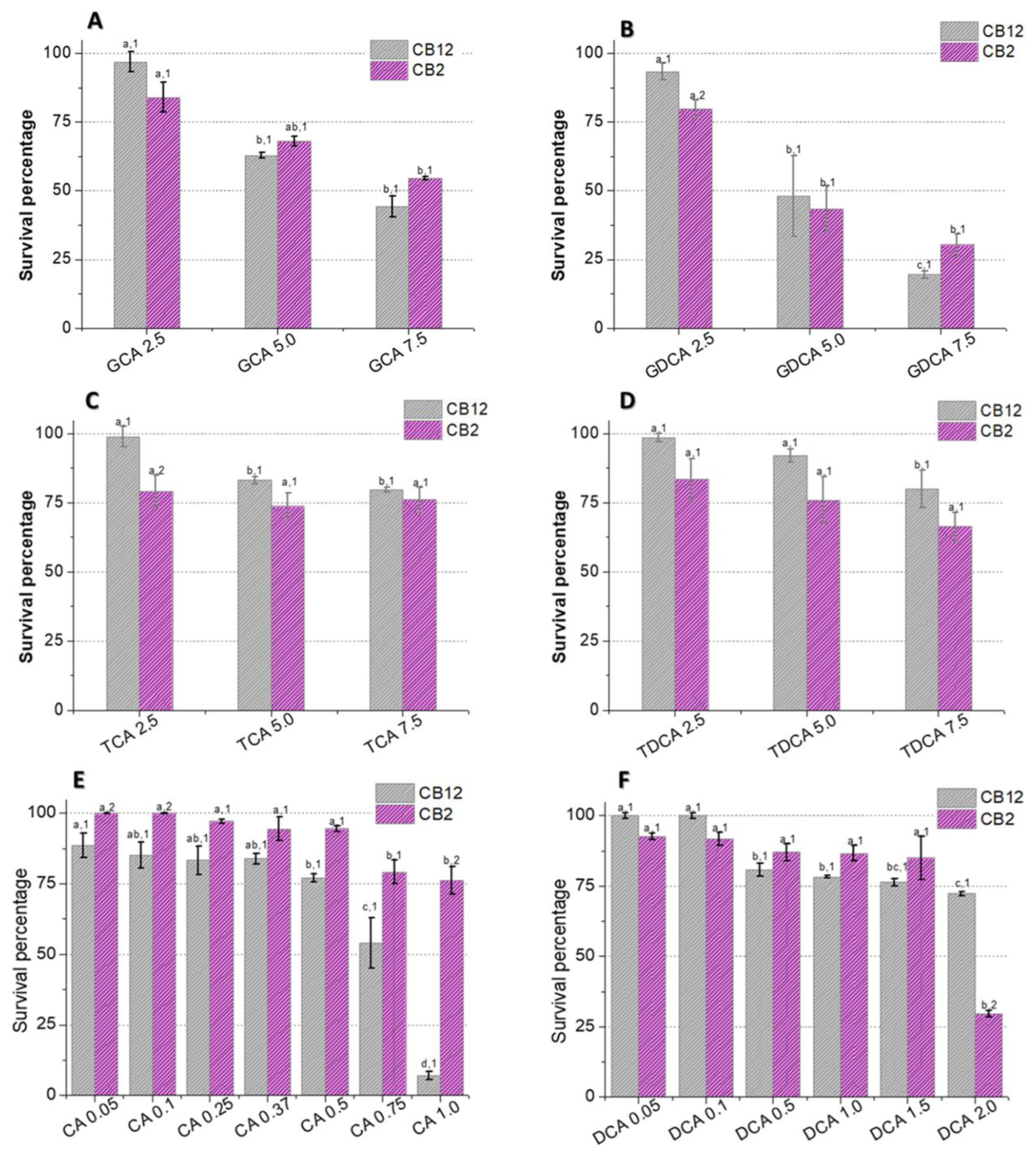
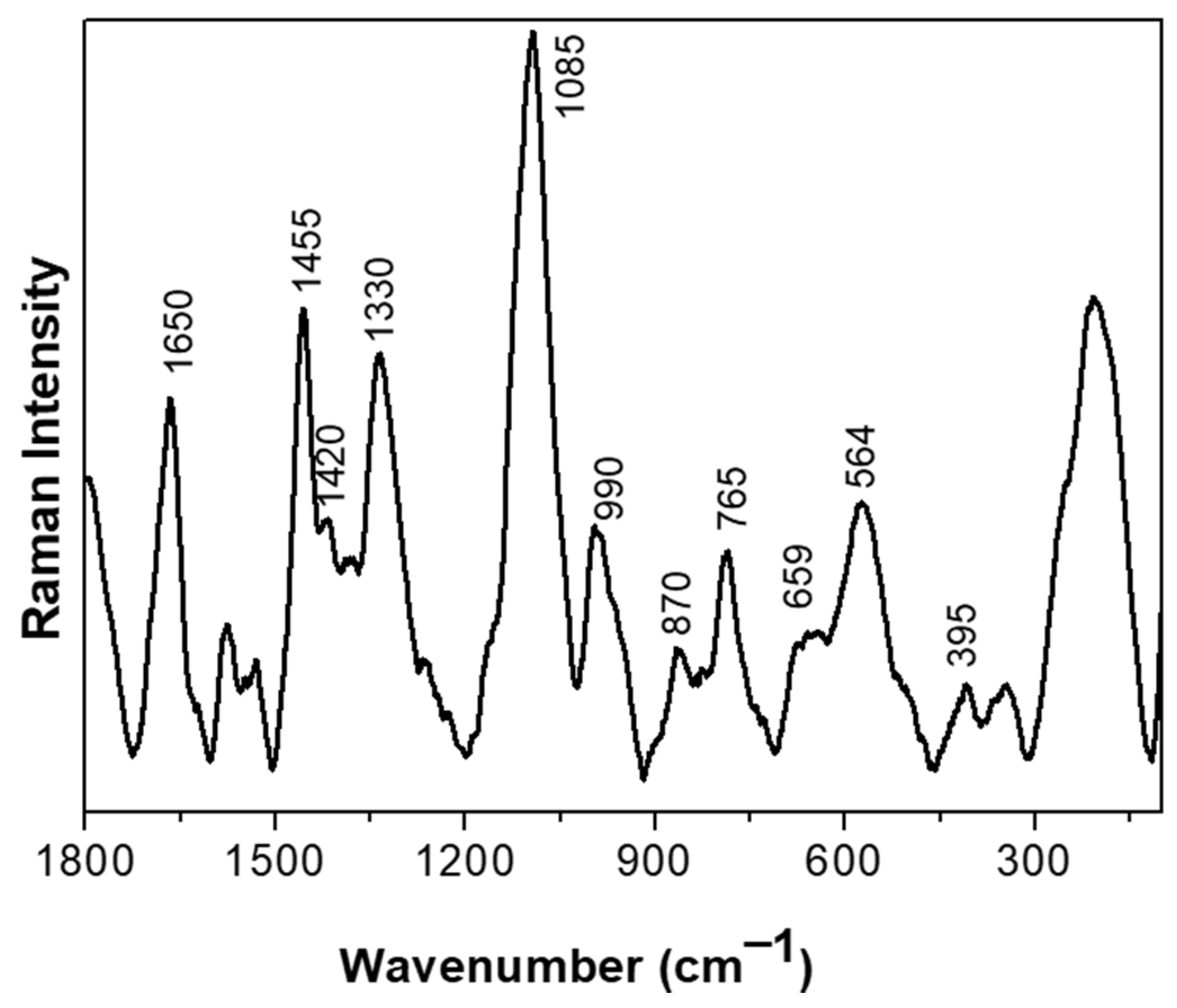
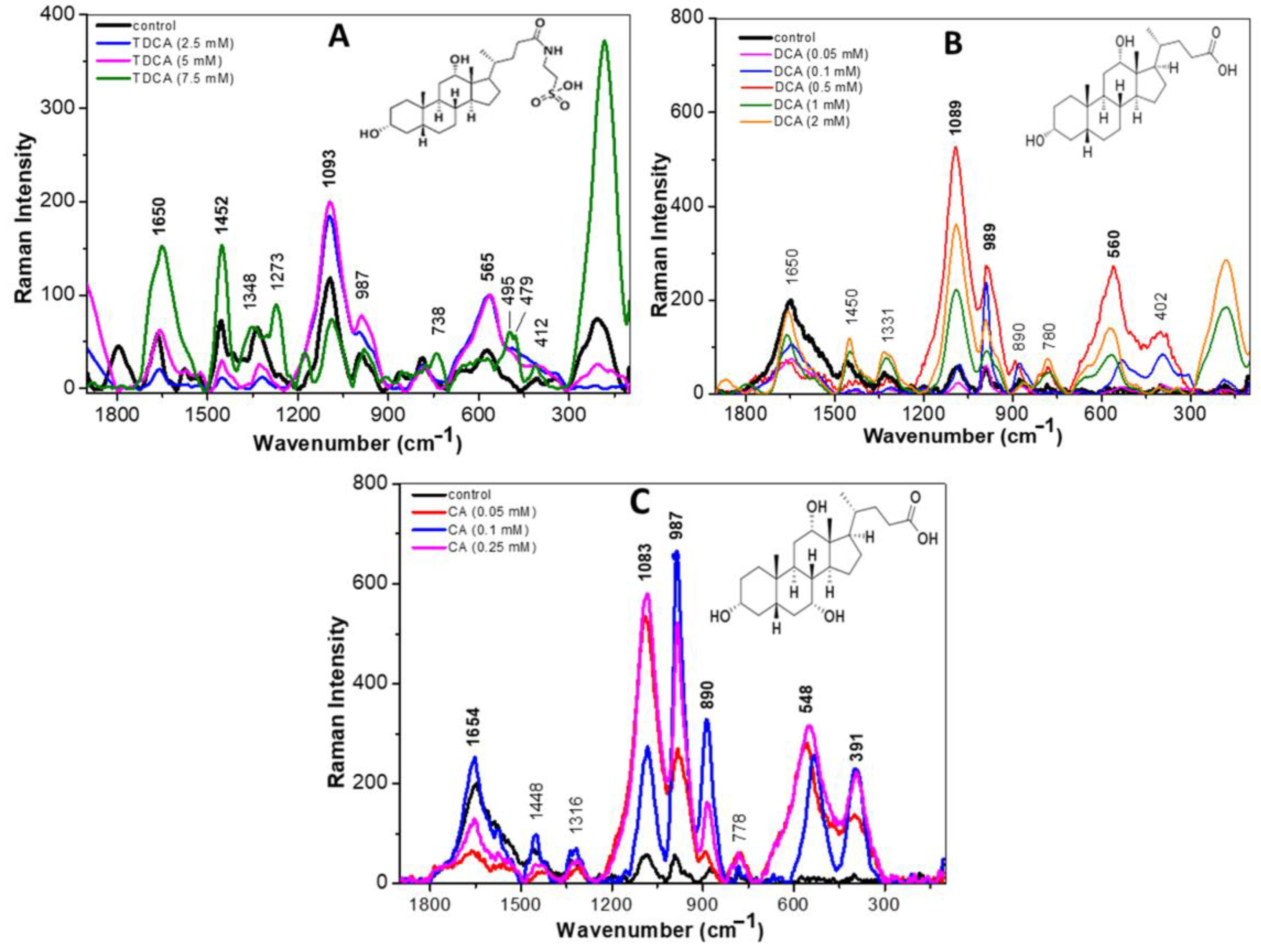

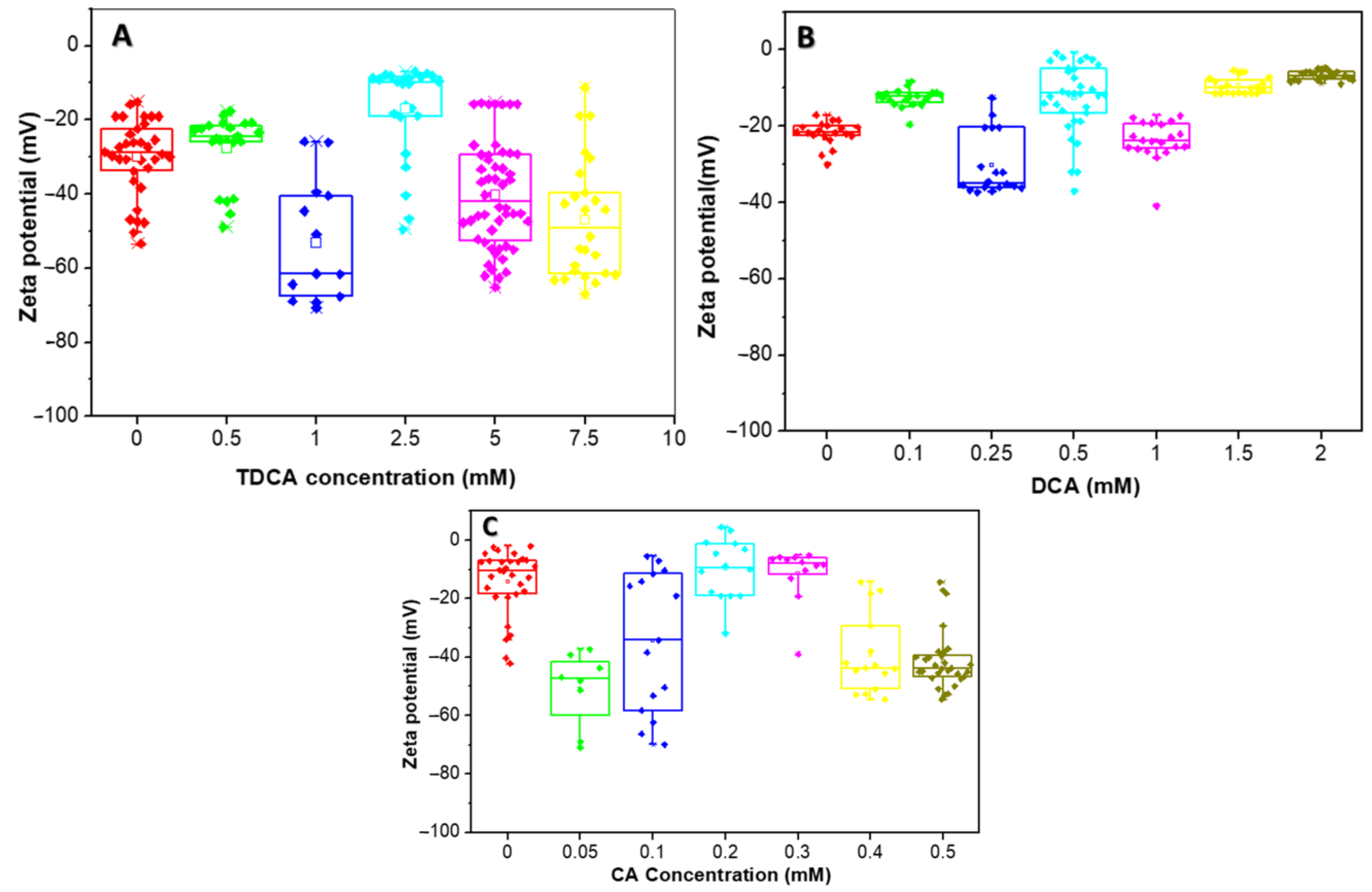
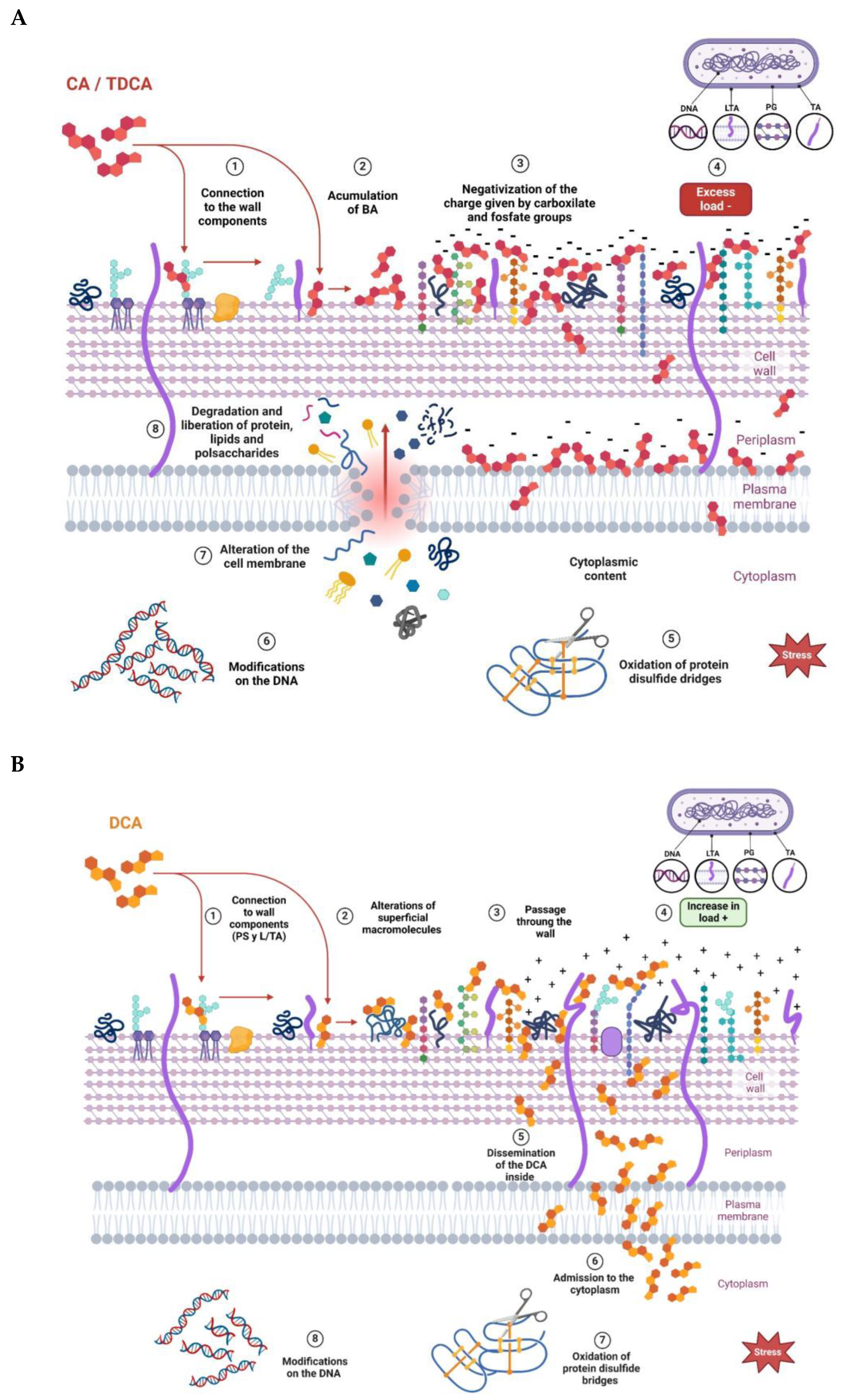
Disclaimer/Publisher’s Note: The statements, opinions and data contained in all publications are solely those of the individual author(s) and contributor(s) and not of MDPI and/or the editor(s). MDPI and/or the editor(s) disclaim responsibility for any injury to people or property resulting from any ideas, methods, instructions or products referred to in the content. |
© 2024 by the authors. Licensee MDPI, Basel, Switzerland. This article is an open access article distributed under the terms and conditions of the Creative Commons Attribution (CC BY) license (https://creativecommons.org/licenses/by/4.0/).
Share and Cite
Moreno, C.N.; Gomez, J.N.; Taranto, M.P.; Ledesma, A.E.; Bustos, A.Y. Molecular Insight into the Response of Lactic Acid Bacteria to Bile Acids. BioTech 2024, 13, 29. https://doi.org/10.3390/biotech13030029
Moreno CN, Gomez JN, Taranto MP, Ledesma AE, Bustos AY. Molecular Insight into the Response of Lactic Acid Bacteria to Bile Acids. BioTech. 2024; 13(3):29. https://doi.org/10.3390/biotech13030029
Chicago/Turabian StyleMoreno, Caren N., Jorge N. Gomez, María P. Taranto, Ana E. Ledesma, and Ana Y. Bustos. 2024. "Molecular Insight into the Response of Lactic Acid Bacteria to Bile Acids" BioTech 13, no. 3: 29. https://doi.org/10.3390/biotech13030029
APA StyleMoreno, C. N., Gomez, J. N., Taranto, M. P., Ledesma, A. E., & Bustos, A. Y. (2024). Molecular Insight into the Response of Lactic Acid Bacteria to Bile Acids. BioTech, 13(3), 29. https://doi.org/10.3390/biotech13030029







